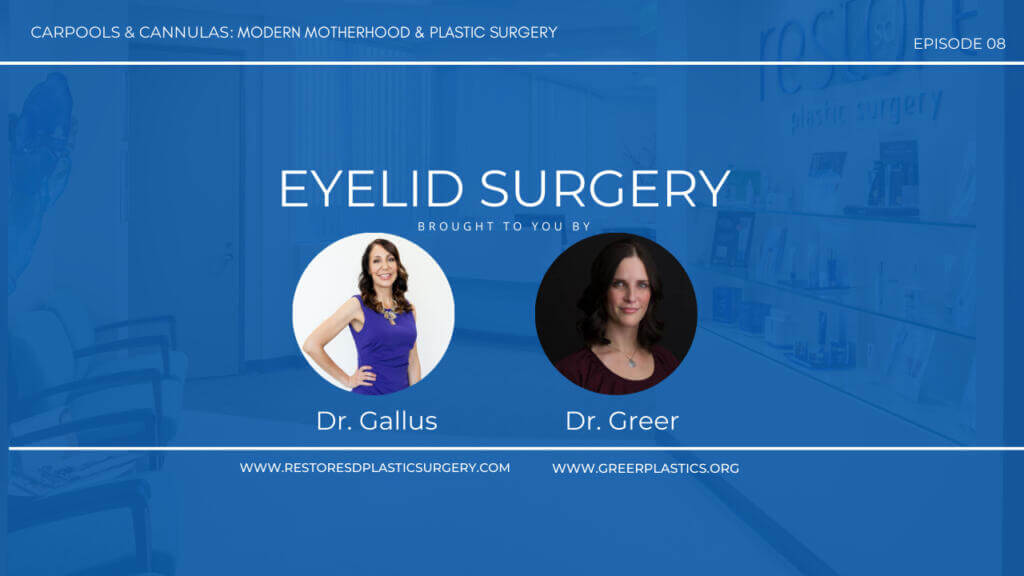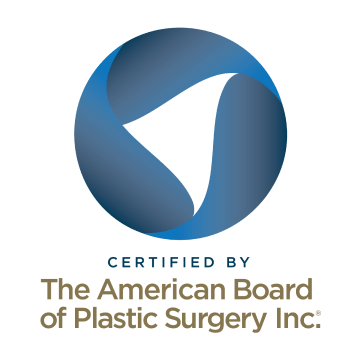On the latest episode of Carpools & Cannulas: Modern Motherhood and Plastic Surgery, we discuss how to turn back time on the eye and brow area. Listen to Dr. Gallus and Dr. Greer as they talk about surgical and non-surgical ways to rejuvenate the eyes.
Transcript
Dr. Gallus: Hi, everybody. Welcome to “Carpools & Cannulas” episode eight, and we’re gonna talk about the eye edit. And I’m gonna wait for Dr. Greer to join us. But my dog is here with me now, so that’s nice. So yeah. So this evening we’re gonna be chatting about everything. Hi, Dr. Greer. Everything that has to do with the eye area, which is, kind of, important in the days of masks. So let me add her in. And she should be popping up shortly. There you are.
Dr. Greer: Hello. How are you?
Dr. Gallus: I’m good. How are you?
Dr. Greer: I’m good. Sleepy, but, you know, it’s like 8:30 here, so that’s practically near bedtime. Yeah.
Dr. Gallus: I’ve been super tired this week and I don’t know why really. No specific reason, so.
Dr. Greer: Yeah, I think just that time of year.
Dr. Gallus: Yeah. It’s time for Memorial Day weekend. Do you have any plans? Are you going anywhere?
Dr. Greer: We’re not going anywhere, but I did put in five raised beds last weekend, and the seven yards of dirt I shoveled may explain the fatigue. But I’m gonna plant some veggies, so that’ll be fun.
Dr. Gallus: Oh, that’s good. Very nice.
Dr. Greer: How about you?
Dr. Gallus: We’re gonna go to Palm Springs.
Dr. Greer: Nice.
Dr. Gallus: I’m seeing a text. So for the weekend, just to go do something. We’re getting a little, you know, Vrbo, taking my three daughters, a couple of extra daughters, a couple of extra kids, and then… Somebody says there’s no sound but hopefully, they can hear.
Dr. Greer: Yeah, well, if I can hear you and you can hear me there’s definitely sound somewhere, so maybe…are you muted? It’s possible.
Dr. Gallus: So anyway. So that’s where we’re gonna go for the weekend. So it’ll be fun. It’s hot.
Dr. Greer: Nice.
Dr. Gallus: It’s like 100 degrees there right now, so.
Dr. Greer: Wow. We opened our pool a little early this year and we swam all last weekend, but this weekend it was supposed to be 55 degrees and raining, so. Yay, Cleveland.
Dr. Gallus: Yeah. It’s nice here, but it’s gonna be much hotter in Palm Springs. It’s the desert, right? So I was just introducing our episode eight, and so we’re talking about eyes, right?
Dr. Greer: Yeah.
Dr. Gallus: So we’re gonna talk about…
Dr. Greer: Surgery, non-surgery, all sorts of things.
Dr. Gallus: Yeah. So what’s your most popular eye procedure?
Dr. Greer: Probably toxin around the eyes. Second to that would be tear trough fillers for sure. I do a ton of tear trough fillers.
Dr. Gallus: Nice. Okay. So do you have a preference for Botox or Dysport around the eyes?
Dr. Greer: Let’s see. You know, I carry Botox, Dysport, Xeomin. Botox, I keep for my brand loyalists, because some people really love Allē points. Xeomin, if I really want pinpoint. I feel like Dysport has a little more spread. It’s like drawing with a little bit wider marker maybe versus a fine tip. But I have probably an equal number of people using Xeomin and Dysport. I’ve been using Dysport on myself lately. I like it. It kicks in fast. How about you?
Dr. Gallus: It does kick in fast. Yes, I would say the overwhelming majority of my patients are Botox users. But I do do Dysport. And because of that kind of diffusion that people talk about, I tend not to use it in the forehead, but it’s really nice around the eyes.
Dr. Greer: It is.
Dr. Gallus: And so, I know people who swear by…Dr. Taylor, who office-shares with me, she will do sometimes Dysport around the eyes and Botox to glabella and forehead and mix and match.
Dr. Greer: No kidding?
Dr. Gallus: Yeah, and then you can play off people’s point systems because you can get ASPIRE points for Dysport. So you can get two coupons and get maybe an Allē coupon. My patients are usually a little more straightforward than that and they just want to get it done. But that spreadability does actually work in your favor for around the eyes, and I think that’s a nice option.
Dr. Greer: Yeah. I use it in the forehead too. I just keep it a little higher so you don’t drop that brow.
Dr. Gallus: Yeah. I’ve never had an issue with it in the forehead, but I do know some people are, you know, pro-Botox to the forehead because of that. And I don’t have Xeomin, so I can’t really speak to that.
Dr. Greer: It’s nice. It’s similar to Botox truly.
Dr. Gallus: I know I’m excited for Revance…
Dr. Greer: Yes, they have a new…
Dr. Gallus: Is it Revance? Yeah, to come out, yeah. So we’ll see how that changes up the market.
Dr. Greer: I know. They’ve been very hush-hush about details, but I think it’s supposed to be pretty long-lasting. So I’m curious to try it.
Dr. Gallus: Right, six months. That would be amazing. I also have patients… My sisters does this. Thanks, Erin, we both do have, like, a lot of lidshow.
Dr. Greer: I actually. I have hooded eyes though. I’ve been watching the YouTube tutorials on eye makeup and, like, there’s not a lot of room in there. You have a nice high arched brow. Mine is kind of straight.
Dr. Gallus: I have a lot of landscape. So I was talking about the Botox to the eyes. I was gonna say people are like, “Oh, you can still see crow’s feet.” And they squish their whole face up. But I have to explain that the muscle around your eye is this, and if you squint, that’s what we’re paralyzing.
Dr. Greer: Or, like, if you raise your whole cheek.
Dr. Gallus: But if you do this, yeah, you’re still gonna get wrinkles no matter what. Okay. Tear trough filler, what’s your go-to for filler in that area?
Dr. Greer: I generally use Belotero. I love that it’s not so hydrophilic. You don’t get a lot of swelling. You don’t get the Tyndall effect, which is the little bluish discoloration you can get from hyaluronic acid fillers just because if they’re under really thin skin…although I do inject it all the way down to the bone, but, you know, the skin and tissue there are so so thin. I love the results though with Belotero.
Dr. Gallus: Nice. I tend to use Restylane.
Dr. Greer: Yeah. I’ve heard… My rep keeps trying to get me to try it. He says, “It’s great. Just try it.”
Dr. Gallus: Yeah, I was using quite a bit of Vollure there for a while. It also goes in really nice, but I feel like it stays around a long time, and if they have any…like sometimes it just gets some post-inflammatory reactions. I haven’t had one personally, but I felt the more I started hearing about it, I didn’t want to, like, end up with that.
Dr. Greer: Yeah. Those products sometimes…
Dr. Gallus: Right. So you get a dental procedure and all of a sudden you’re, like, swollen around your eyes. That’s not a good look, so.
Dr. Greer: Yeah, not at all.
Dr. Gallus: Yeah. So I have been using a lot of Restylane-L. And I dilute it. You don’t have to dilute Belotero though, huh?
Dr. Greer: No, it’s very thin and very elastic, which is why I like it. That’s what I use. Like, that’s pretty much the only thing I use Belotero for, because I love my Restylane products. I hope my rep is watching this. He’s not. But I do love Belotero around the eyes. But then, you know, I do a fair amount of eye surgery as well. That’s probably my biggest procedure though is the tear trough filler.
Dr. Gallus: Do you do cannula or you…?
Dr. Greer: I just do straight-up needle injection, 90 degrees. Yeah, I’ve tried [inaudible] certainly don’t want that.
Dr. Gallus: Yeah. I say the same thing. I’ve tried cannula before and I just don’t feel like I have the same precision in that area as I do with sharp injection. And it just…sometimes, getting through those tissues is just, you know, uncomfortable. So a little numbing cream and then…
Dr. Greer: A little ice. Yeah.
Dr. Gallus: Yeah.
Dr. Greer: It’s a nice treatment though. It makes all of us moms look slightly more awake.
Dr. Gallus: Yeah, less tired. Absolutely. And I do recommend a good eye cream too for that. If somebody is complaining of dark circles under their eyes, that can help. But a lot of times, just filling that area out can help.
Dr. Greer: Yeah, but that skin gets so dry so easily. Now that I’m 40, I do use eye cream fairly regularly because otherwise it just looks kind of creepy and crinkly and it helps. And I’m betting we both use the Alumier AluminEye.
Dr. Gallus: Yes, AluminEye.
Dr. Greer: Yeah. I love it.
Dr. Gallus: They have one that has retinol in it, right? But I don’t use that one. That’s too [inaudible 00:08:39] for me.
Dr. Greer: Yeah, they do. Actually, I use the regular retinol right up to my lower eyelid and then throw on the AluminEye afterward. It’s nice.
Dr. Gallus: Yeah. I do like the AluminEye. I’ve tried multiple products with retinol in it, eye creams that have retinol, and it always like…
Dr. Greer: Breaks you out.
Dr. Gallus: …trashes my skin, yeah.
Dr. Greer: It’s just delicate. Oh, I see, Erin wants to hear about actual surgical procedures, upper bleph, lateral brow lift. Erin, you always, like, lead us into the next topic. I feel like you guys have prepped beforehand.
Dr. Gallus: She’s my hype woman.
Dr. Greer: I know. She’s good. I gotta say. I love the lateral brow lift. I learned about it in, like, a group discussion and read the paper and I’m like, “This is nice.” So I don’t know. Do you want to jump into brow lift and eyes now or…?
Dr. Gallus: Sure. Let’s talk about it. Yeah.
Dr. Greer: So brow lift. There’s a couple of different kinds. I was trained with either. You do the pre-tracheal incision right in front of the hairline, or you do the full coronal. So that’s an ear-to-ear incision. We never did endo brow, which is just small little incisions, and you’re basically taking out the muscle. So for me, it was either, like, big open brow or big open brow, which…it’s a kind of a pain in the butt surgery and the results aren’t dramatic usually. I mean, they’re like a subtle improvement.
Dr. Gallus: Right. Yeah, I didn’t train with those. We did the endo brow, but those, I feel like are sometimes a subtle result as well.
Dr. Greer: Yeah. I mean, because with, you’re getting some lift, right? Because you put in anchors.
Dr. Gallus: Right. You’re just moving the skin back a little bit and…
Dr. Greer: Exactly, and removing the corrugator muscles. So the lateral brow… Oh, hype woman on your business cards? Yes. So the lateral brow, it’s just right here. It’s just over the eyebrows, and it just gives that little… See I need one. Maybe I’ll come see you and you can give me… I just need an arch like that. Erin’s right. But it’s nice because it’s a much simpler surgery and it gives pretty much the same amount of improvement and easier recovery.
Dr. Gallus: Yeah. And so do you do those under general or local?
Dr. Greer: I will do them under local if patients prefer, but there’s so much vascularity there it can get a little sketchy sometimes. I usually prefer general just for that reason. So many big veins in the scalp.
Dr. Gallus: I know. Erin wants me to do hers, so we’ll see. Maybe we’ll…
Dr. Greer: Erin, we can all come out and we can get them together. Here we go. Hey, my Revance rep just joined. You missed us talking about your new toxin, Kyrsten. We’re excited to hear more and learn about it. She’s not allowed to respond or comment, I think. Company policy. But I see her, so, hi.
Dr. Gallus: Yeah. So I think that…what do you do if somebody has more of a medial brow issue? Or is it almost always lateral? I think most people can get away with lateral. Very few people have that.
Dr. Greer: Yeah, really, really…if you carry that lateral brow to here, you can still….
Dr. Gallus: You can pretty much get away with it. Yeah.
Dr. Greer: Yep. And for people who don’t realize this, the brow is kind of the foundational element when you’re looking at the forehead upper lid. Because if your brows have dropped and you do an upper bleph, you can just pull them down farther. It’s not good. So you’ve gotta… I love reading Erin’s comments. Have of these things are me going, “Yes, 20s.” And we’re both brunettes too. But yeah. If you don’t set the position of the brow before you take off the excess skin on the eyelid, you look the same afterward.
Dr. Gallus: Yeah, I agree. Yeah. And then brow position though. I did somebody in consultation who had a browlift somewhere else and it was direct, so just at the eyebrow incision, which I don’t do. I mean, I just…
Dr. Greer: I don’t either.
Dr. Gallus: …whatever.
Dr. Greer: You have small people running by… kids, haha. I feel like that sebaceous skin sometimes, those scars can indent a little bit and I don’t love that.
Dr. Gallus: Definitely. But it was in a man and so they did just do lateral brow and it looked very feminizing. I know we talked about male plastic surgery last week, but yeah, I think you have to be careful. There is definitely an ideal for women, an ideal for men, and they’re not the same. Otherwise, you get feminized-looking men and it just… The average person doesn’t know what it is. They just think it looks weird.
Dr. Greer: Right. See, I have a very masculine brow. See, it’s very straight.
Dr. Gallus: Yeah, it’s very straight.
Dr. Greer: It’s okay. I will probably need a browlift someday. But, you know, guys are the one exception where sometimes I won’t do a browlift. Oftentimes, browlifts in guys are tricky too because there’s not always good hair to cover, no offense. Right. But you can also leave a little bit more skin and it just makes them look awake and not so sleepy.
Dr. Gallus: Yes. They just want a little freshen up. They’re usually not trying to overdo it and make it more subtle. And so I think just doing an upper lid lift, which is what we should talk about next, since Erin is not gonna segue us there, is, you know, without the browlift, is a nice procedure. And I do that under local often. I just, you know…plus or minus if somebody wants to take a little sedative, numb the area up, and then, I mean, you just keep your eyes closed and I can do your whole procedure and we’re done. And then the suture comes out at about a week. So that’s how I do it, pretty much.
Dr. Greer: So when I initially trained, I did a subcuticular absorbing stitch… and this technical talk may bore you guys, but I got a couple of suture granulomas and you could see this little like S-curve, which sucked. So then I did the prolene pull-out stitch, but it’s… You know, what I’ve switched to is actually doing Dermabond over the pull-out stitch.
Dr. Gallus: Oh, you have?
Dr. Greer: Yep. And I remove the pull-out stitch while they’re still asleep, which is just easier sometimes. Sometimes, it’s a little tricky to get out. And then that Dermabond peels off after about a week.
Dr. Gallus: Oh. So do you tell them not to put ointment on their eyes? That would be my concern.
Dr. Greer: I do. Yeah, because sometimes they’re like, “I put ointment.” But I feel like eyes heal so fast. If those incisions are touching for two days, they’re practically healed.
Dr. Gallus: That’s true. That’s true. Although I did just recently have someone who was a little over a week out because I had taken out the pull-through stitch and then went to do this with her hair and, like, poked herself in the eye. And so, she had a little opening. But, again, I just brought her back in, put two little stitches in, and took them out, you know, and it was fine.
Dr. Greer: Yeah, it heals well. I had a patient…
Dr. Gallus: Yeah. It does. It’s very tolerant.
Dr. Greer: I had a patient pop open the lower eyelid incision. She got rear-ended and hit her face on the steering wheel like a week after. Yeah, and she had just this tiny little depressed scar and we left it and let it settle. And then I put just this tiny little bit of filler the next time we were filling her lips and it’s perfect now. Eyes are very forgiving that way.
Dr. Gallus: Yeah, they are. Yeah, so…and she’s also… What about lower? So upper lids, okay. I’m gonna have to, like, level up and try the Dermabond. I will put Dermabond on there but I still do the pull-through, which sometimes it comes out magically, and sometimes you’re pulling.
Dr. Greer: I had one get really stuck and it was really uncomfortable for a patient, and that’s when I tried the Dermabond. And I like it. I still do the full subcuticular stitch so I get really good approximation and then I just pull it out after the Dermabond dries, which is nice. But upper lids are definitely simpler than lower, because upper lids, we’re literally taking a strip of skin and, like, a little bit of fat. In lower lids, you gotta fight gravity, you gotta worry about cheekbone prominence because you don’t wanna end up like this.
Dr. Gallus: Yes, or little beady eyes or…yeah. There’s a lot that can…there’s a lot more finesse with the lower lids for sure.
Dr. Greer: Yes.
Dr. Gallus: I think the simplest procedure is a skin pinch. Actually, when people have just little extra crepey skin, I think the simplest thing to do is laser, CO2 laser, to get some skin tightening.
Dr. Greer: Yes. Now, I have not done this. I have a friend who’s got the Sciton, same one I do, and she said she uses the spot treatment, like, the small spot. What are your endpoints? Like, what are you looking for and how deep do you go?
Dr. Gallus: I have the Rohrer, the Phoenix, and so I just double pass at a pretty high density and depth and just go across this, you know, chars.
Dr. Greer: And then tighten things up?
Dr. Gallus: Yeah. And it takes a little…I mean, it’s a slow roll, but then you’re not having, you know, a surgical procedure.
Dr. Greer: Right, I feel like… Recovery time is still a couple of weeks though, right? It’s pretty raw.
Dr. Gallus: Yeah. If people are really nervous about surgery though, it’s a nice entry point, because then you’re just doing laser. Yes, you’re right. You’re not gonna be on a Zoom call looking normal with your lower lids lasered for sure, not for at least a week, maybe two. And you get pretty swollen. I’ve done mine on and off at a lower setting just to get some skin tightening. I have a very annoying vessel right here that shows up, and I thought, “Okay, if I just periodically laser my lower lids, it thickens the skin and will make it less prominent.” Somebody once suggested just making a little stab incision and yanking it, but that just makes me kind of want to vomit, so no.
Dr. Greer: I feel like you would be very bruised after that. Yeah. I did some of the vessel stripping in residency and it was very fun, but very much traumatic.
Dr. Gallus: Yeah, it was.
Dr. Greer: Right.
Dr. Gallus: But even with that low setting, it’s swollen and puffy. It’s not, like, not noticeable.
Dr. Greer: Yeah, exactly.
Dr. Gallus: Yeah, so with the skin pinch, I feel like that’s the next level up is just…if you just have some thin, crepey extra skin, just take a little bit of skin off. And then the most other common things that people complain about are the tear troughs and then bags under their eyes, right? Those are the two things we address.
Dr. Greer: So then you’re either removing fat or adjusting fat, and that’s a little more invasive. You’re a little more swollen afterward.
Dr. Gallus: And so what’s your go-to? I think I prefer…for most patients, I prefer going transcutaneous…or not transcutaneous. Trans…
Dr. Greer: Transconjunctival.
Dr. Gallus: Yeah.
Dr. Greer: So that’s, for all of you nondoctors, it’s an incision in the lid, and that’s what I do most of the time just to remove fat. But if I need to… If you have, like, this really deep groove here and your eyelid is inset on the back of your cheekbone, releasing that makes a nice difference, and that I like to do through a skin approach. I just find it easier.
Dr. Gallus: So yeah, I like to go transcon to get the fat pads, address that. You can still kind of disrupt that arcuate line via that. And then if they have any skin, I’ll do a skin pinch, but I’ve also done a skin muscle flap, just open it up, get what you need to do, and put it back down.
Dr. Greer: And then resuspend.
Dr. Gallus: Yes. Absolutely. So yeah. So we’re talking about putting a suture in that holds that lateral part of your eyelid to the bone that’s behind it because, you know, when you go in there and operate, we don’t wanna have…you wanna make sure that that lid has support while it’s healing so you don’t end up with…
Dr. Greer: Right, and that’s where you have to be a bit cautious because you don’t wanna get the smaller eyes. You don’t wanna make the eyes look smaller.
Dr. Gallus: Right. Kenny Rogers effect.
Dr. Greer: Oh, I never noticed it on him.
Dr. Gallus: Oh, my gosh, he had small beady eyes. And remember when Madonna was running around with an eye patch, I think the running theory amongst plastic surgeons was that she had had eyelid surgery and there was a complication, so that was her workaround.
Dr. Greer: She pulled it off.
Dr. Gallus: I was like, “Let’s bring the eyepatches back. That’ll be cool.” So who knows what was behind that patch?
Dr. Greer: I know I always wonder. Oh my gosh. We have this family text conversation that’s going right now. My phone keeps blowing up. I don’t even know what it’s about.
Dr. Gallus: That’s okay. At 8:30? Don’t they know it’s bedtime?
Dr. Greer: Apparently they don’t know that I go to bed at 8:30, so….they’ll have to learn. I’m real life of the party here.
Dr. Gallus: Yeah. So let’s see. What have we not covered with eyelids? What do you think?
Dr. Greer: Well, eyelashes are sort of critically important. And I have had Latisse or Careprost or RevitaLash on my lashes for, like, the last eight years. I kind of forget what they look like without it. They’re much shorter.
Dr. Gallus: Yeah, I agree. I’m like a huge Latisse fan and use that as well. And I think it really does make a difference. The thing about Latisse is… You’re insane. He looks so bad. Yeah. Kenny Rogers did look… That’s very feminizing. It was bad.
Dr. Greer: Well, and it was, like, a lot of surgery. I don’t think that you could get that transformation in one operation, even if you’re super aggressive.
Dr. Gallus: Yeah, you have to keep picking at it. Oh, yeah, so Latisse. I feel like it takes about three weeks for you to see an effect and then it takes about that long to wear off. So, you know, if you don’t do it, I feel like I’ve gotten off… We had to remodel our master bathroom at one point because there was a leak and so it just disrupted my whole game and I stopped doing the Latisse and I thought, “Well, whatever.” And then all of a sudden, you wake up one day and you’re like…
Dr. Greer: You’re like, “They’re gone.”
Dr. Gallus: Where are my lashes? What happened?
Dr. Greer: That’s what happened during my first pregnancy and then I was like, “Yeah, I don’t think it’s systemically absorbed.” I may continue it for babies too because they were really these little tiny stubs. I missed them.
Dr. Gallus: Yeah. So it’s an easy thing that works. And then I personally haven’t had any issues with it irritating my lids, but I know that some people find that irritating. I don’t know.
Dr. Greer: Yeah. My mother-in-law finds different brands irritating. Like, she tried a non-Latisse generic and that was irritating, and then Latisse, she is fine with. She hasn’t tried RevitaLash. That one is just a different prostaglandin and it works pretty well, too.
Dr. Gallus: Right. I’m sure they all have some conditioning agents too in it to help.
Dr. Greer: Yeah. I also like to do my eyebrows because they were getting a little sparse and now I have to trim them. They’re like old men…you know the old men who have, like, the crazy eyebrows?
Dr. Gallus: Yeah, I have a couple of those.
Dr. Greer: It’s nice.
Dr. Gallus: Yeah, I do wipe off the excess on my brows. There are some spots that are not Latisse-resuscitatable though, so I’m probably gonna get my brows microbladed, so we can talk about that in a different session.
Dr. Greer: I didn’t know…I’ve seen some really good microblading. I’ve seen some less good microblading.
Dr. Gallus: I’m pretty sure mine will be okay. I’ll let Erin go first. So, she tried early.
Dr. Greer: She’s the guinea pig. Sorry, Erin. You go for the browlift for me too. And I also have…I want the Kenny Rogers ultra-feminized super surprised.
Dr. Gallus: You want them super high?
Dr. Greer: Yeah, I wanna look really surprised. This is like everybody’s fear. I don’t think I could get somebody’s eyebrows out here with, like, out drilling anchors into their skull and, like, suspending their skin. It would be so hard to get the brow to do that.
Dr. Gallus: Right. That’s usually the opposite problem. However, I’ve seen some whacked thread lift situations where they do that, but then it falls.
Dr. Greer: Thread lifts are just… People ask about them all the time and they, like, come into vogue and go out of vogue. So basically, they’re these dissolvable threads that give some lift, but the problem is they’re not always even and they don’t always dissolve at the same rate or you end up with weird bunching. Hello, small child. I have a child and a dog. Good times. But yeah, the thread lifts, you can definitely get some…
Dr. Gallus: Wonky stuff. And then it doesn’t last that long. I do do Botox here to raise…
Dr. Greer: To get a little lift.
Dr. Gallus: To get a little lift.
Dr. Greer: And we didn’t mention the Spock brow. So if you guys have ever seen somebody who had Botox and they’re like this afterward, it’s called the Spock brow. There’s a name for it after, obviously, Spock, and what happens is if you don’t carry the toxin far enough out here, they get a lot of lateral motion.
Dr. Gallus: Right. And so that’s the only part of your… I know it is a style right now for the eyelid lifts and the Spock brow. What I tell people is I’d rather laterally lift your brow a little bit. That’s more natural-looking than paralyzing the central part of your forehead so that when you move it, it comes up. But I feel like Gigi Hadid might have popularized that amongst young people on Instagram. So yeah. I mean, a little bit of lateral left is nice. I just think…
Dr. Greer: Right. You don’t want too much. Yes. That’s one of the things. I like to text new toxin patients a week out and be like, “How are things?” Because often, you know, they don’t, like, love it, but it’s not enough to call you. And if you text them, they’re like, “Oh, well, my eyebrow’s up a little.” And I’m like, “Well, come in. I can tweak it,” yeah.
Dr. Gallus: Yeah, I always tell people they can come in at two weeks. Because sometimes, especially for the new patients, like, I’ve done it where you can tell one half of the forehead is stronger and so you put a little bit more there. But it doesn’t work that way because your forehead, your muscles, want pull, right? And so then it ends up not compensating and you just end up chasing your tail. So we just start out with even-steven, and then if I have to tweak it, I’d rather tweak it.
Dr. Greer: Yeah. And that’s one of the things people miss out on when they…if they are hopping around for Groupon deals, you miss out on having… Hi, Wyatt. You can come say hi. Wave, wave. Say hi. That’s Dr. Gallus.
Dr. Gallus: Hi, Wyatt.
Dr. Greer: You what? Your teeth. Okay. We’re not gonna play mind games right now, bud, nice to see you.
Dr. Gallus: Can he sign? Is he signing for you?
Dr. Greer: No. We know more, all done, mom, dad. We’ve been trying to teach my baby sign. She’s two and she’s got more, and she did do eat one day. Mostly, she just grins at you and then steals your cell phone out of your pocket and runs away. But yeah, what I was saying is it’s really good to keep with the same consistent injector, or at least the same office, because if I have a patient who’s not super straightforward or a little complicated, I’ll draw markings and take a picture so it’s in our Dropbox folder and people can look and be like, “Oh, that’s exactly where you did it. Okay.”
Dr. Gallus: Right, right. Yeah. Sometimes, it takes a little while to get…You know. And then when someone comes in and they’ve been in other offices. And I’m like, “Well, how many units did they use?” “I don’t know.” You have to start all over again.
Dr. Greer: Right. It’s like getting a stylist who knows your hair and that’s really important. I mean, we have patients who only see my nurse injector, Val, because she knows their forehead, and we have patients who only see me, and that’s…I respect that. They get consistent results.
Dr. Gallus: Yeah. I agree. All right. Well, I think it’s time to wrap it up. We should just talk about what we’re gonna talk about next.
Dr. Greer: I know. And then we forget, which is, sort of, hilarious.
Dr. Gallus: I know, and then I’m like, “What did we agree to talk about?”
Dr. Greer: Yeah, maybe we should talk about crepey neck skin. Did we talk about that yet?
Dr. Gallus: Yeah, we should talk about that.
Dr. Greer: Because I always have people ask about that and there’s so many surgical and non-surgical injectables, Dilute Radiesse, things like that that we can talk about…
Dr. Gallus: Yeah, we can talk about that experience.
Dr. Greer: You know where I actually learned about that was watching “Real Housewives.”
Dr. Gallus: Dilute Radiesse.
Dr. Greer: Yeah, I think it was “Orange County,” because it was Lisa Vanderpump was getting it, and I’m like, “What? Who puts Radiesse in their neck? What is this?” That’s where I learn things. It’s from television, and Facebook. So yeah, let’s talk neck things, and I’ll host in say two weeks, unless one of us has a meeting.
Dr. Gallus: Sounds good. All right.
Dr. Greer: Awesome. I will see you soon.
Dr. Gallus: Good to talk to you. Have a great evening.
Dr. Greer: You too. Bye.
Dr. Gallus: Bye.
About Restore SD & Dr. Katerina Gallus
As the Director of Restore SD Plastic Surgery, board certified female plastic surgeon Dr. Katerina Gallus has over 15 years of experience helping San Diego women enjoy head to toe rejuvenation with face, breast and body procedures. After a successful career as a Navy plastic surgeon, Dr. Gallus founded Restore SD Plastic Surgery with the intention of creating a welcoming space for anyone seeking cosmetic enhancement.
Restore SD Plastic Surgery offers popular facial rejuvenation procedures like facelift & neck lift, facial fat grafting, and eyelid lift; breast augmentation with implants, breast lifts or breast reduction; body contouring procedures such as tummy tuck, liposuction, mommy makeover, and Brazilian butt lift (BBL), as well as aesthetician services, BOTOX, injectable fillers, and laser treatments.









